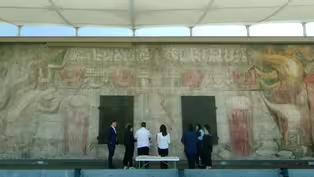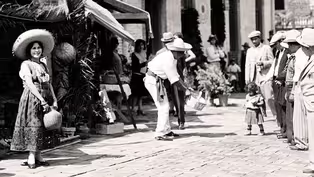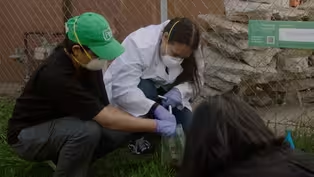
Street Meeting': Siqueiros's Controversial Pro-Union Mural
Clip: Season 14 Episode 2 | 4m 38sVideo has Closed Captions
David Alfaro Siqueiros’s "Street Meeting" confronted an anti-union climate in 1930s L.A.
David Alfaro Siquieros's provocative mural "Street Meeting" challenged racial prejudice and hostility around labor organizing in 1930s Los Angeles. Depicting a multi-racial union meeting, the mural was met with backlash and destroyed shortly after its unveiling. Today, paint and mural experts engage in efforts to preserve the legacy of Siqueiros's muralism in L.A.
Problems playing video? | Closed Captioning Feedback
Problems playing video? | Closed Captioning Feedback
Artbound is a local public television program presented by PBS SoCal

Street Meeting': Siqueiros's Controversial Pro-Union Mural
Clip: Season 14 Episode 2 | 4m 38sVideo has Closed Captions
David Alfaro Siquieros's provocative mural "Street Meeting" challenged racial prejudice and hostility around labor organizing in 1930s Los Angeles. Depicting a multi-racial union meeting, the mural was met with backlash and destroyed shortly after its unveiling. Today, paint and mural experts engage in efforts to preserve the legacy of Siqueiros's muralism in L.A.
Problems playing video? | Closed Captioning Feedback
How to Watch Artbound
Artbound is available to stream on pbs.org and the free PBS App, available on iPhone, Apple TV, Android TV, Android smartphones, Amazon Fire TV, Amazon Fire Tablet, Roku, Samsung Smart TV, and Vizio.
Providing Support for PBS.org
Learn Moreabout PBS online sponsorshipI had the pleasure of meeting David Alfaro Siqueiros in the early summer of 1932.
I met him at a series of parties, and being a young artist wanting to know more about new techniques, I persuaded him to teach some eight of us fresco painting.
I was teaching at Chouinard at the time, and Mrs. Chouinard graciously gave us the building in which to conduct the class, and we had a very exciting experimental period of a couple of weeks where he showed us many different techniques.
It was during this period that he conceived of the idea of doing the mural at Chouinard on one of the walls in the main court.
The mural was representing a union meeting.
When you look at it, it takes into account workers and it depicts black, white and a variety of construction workers Latinos, Mexicans, a mixture who are overlooking.
Listening to this, a union organizer who's in the central figure in a red shirt representing socialism and the metaphors.
But it's also important to understand because it becomes the first experiment of outdoor murals, the innovation that Siqueiros brings with his work and his curiosity and his experimentation.
Street meeting shows us what we can do about it.
He wanted us to organize, so he gave birth to a lot of activists.
Not only did it identify the problem, he also told us what needed to be done organize, organize, organize and stand up for social justice and stand up for your rights.
-Which, of course, unfortunately, no.
In the United States it all got lost in that discussion about race and racial prejudice that unfortunately led to the destruction of the mural.
And the reason why the mural was destroyed is that somehow it portrayed a bi racial couple.
-We're talking about 1932 when bi racial gatherings weren accepted.
- It becomes very controversial because it shows a union organizer with a black man and child and a white woman with her child and a scaffold full of construction workers listening to him.
L.A. was an anti-union town and they were busting up unions.
It was the L.A. Red Squad, which they were known because they would target communist socialists and the activists that were contrary to the city administration at that time.
So that mural is immediately covered over.
For instance, here you see delamination of the material here.
It's come off.
So there's going to be some extensive work in here to get that glued back into place.
Paint and mural experts have started the painstaking job of opening up small sections to determine just how much of Street Meeting remains.
I think the legacy of Siqueiros in Los Angeles will be his murals that he made while he was here.
They're so beautifully done, so important to all of us, just as important as like a lot of the Western European artists are.
He's he's someone that really should be appreciated.
And so I think the fact that they're preserving his murals is also really wonderful because some some it's some murals are are destroyed or neglected.
Unfortunately, a lot of the issues that Siqueiros conveyed at the time are still existing today.
América Tropical: The Martyr Mural of Siqueiros (Preview)
Video has Closed Captions
Preview: S14 Ep2 | 30s | David Alfaro Siqueiros created Olvera Street’s popular mural with an innovative technique. (30s)
How Olvera Street Became the Tourist Spot We Know Today
Video has Closed Captions
Clip: S14 Ep2 | 2m 8s | In 1932, Christine Sterling sold the idea of Olvera Street to boost L.A.'s tourism. (2m 8s)
How Prospering Backyards Unifies Art, Science & Community
Video has Closed Captions
Clip: S14 Ep2 | 5m 51s | Prospering Backyards fights Exide lead soil contamination with art, science & community. (5m 51s)
Providing Support for PBS.org
Learn Moreabout PBS online sponsorship

- Arts and Music

Innovative musicians from every genre perform live in the longest-running music series.












Support for PBS provided by:
Artbound is a local public television program presented by PBS SoCal



